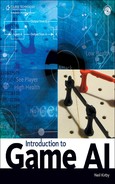0%
15Chapters
0-1Hours read
0kTotal Words
Book Description
Today's game players expect increasingly realistic interaction within games. "Introduction to Game AI" teaches readers who are new to game AI the skills they need through hands-on projects based on small, understandable games. While there are many books that take a more advanced approach to this topic, this is one of the only books that focuses specifically on beginners. Every project in the book can be completed using tolls that are available for free online, and new skills are taught using easy to follow instructions and examples.
Table of Contents
- Copyright
- Acknowledgments
- About the Author
- Introduction
- 1. What Is Game AI?
- 2. Simple Hard-Coded AI
- 3. Finite State Machines (FSMs)
- 4. Rule-Based Systems
- What Is a Rule-Based AI?
- Design and Analysis
- Advantages
- Disadvantages
- The Minesweeper Project
- Implementing the Basic Game
- The Playing Field
- Squares
- Adding Squares to the Playing Field
- Turning Plain Squares into Mines
- Neighbor
- Making It Playable
- Making It Fun: Adding Flags and a Safety Feature
- Implementing the AI
- The AI Needs to Think Out Loud
- Rules
- A Rule for Single-Square Evaluation
- The Framework
- Adding the Framework to the Game
- Rules for Two-Square Evaluation
- A Two-Square Evaluation Rule Using Near Neighbors
- Two-Square Evaluation Using Non-Adjacent Squares
- Do We Need More Rules?
- Implementing the Basic Game
- Chapter Summary
- Chapter Review
- Exercises
- References
- 5. Random and Probabilistic Systems
- 6. Look-Ahead: The First Step of Planning
- Evaluation Functions
- Pruning
- Heuristics
- Discrete Moves
- Knowledge Representation
- Advantages to Look-Ahead
- Disadvantages
- Applicability
- The Fox and Hounds Project
- Chapter Summary
- Chapter Review
- Exercises
- References
- 7. Book of Moves
- 8. Emergent Behavior
- 9. Evoking Emotions on the Cheap
- 10. Topics to Pursue from Here
- Answers to Chapter Review Questions
- Chapter 1: What Is Game AI?
- Chapter 2: Simple Hard-Coded AI
- Chapter 3: Finite State Machines (FSMs)
- Chapter 4: Rule-Based Systems
- Chapter 5: Random and Probabilistic Systems
- Chapter 6: Look-Ahead: The First Step of Planning
- Chapter 7: Book of Moves
- Chapter 8: Emergent Behavior
- Chapter 9: Evoking Emotions on the Cheap
- Chapter 10: Topics to Pursue From Here
